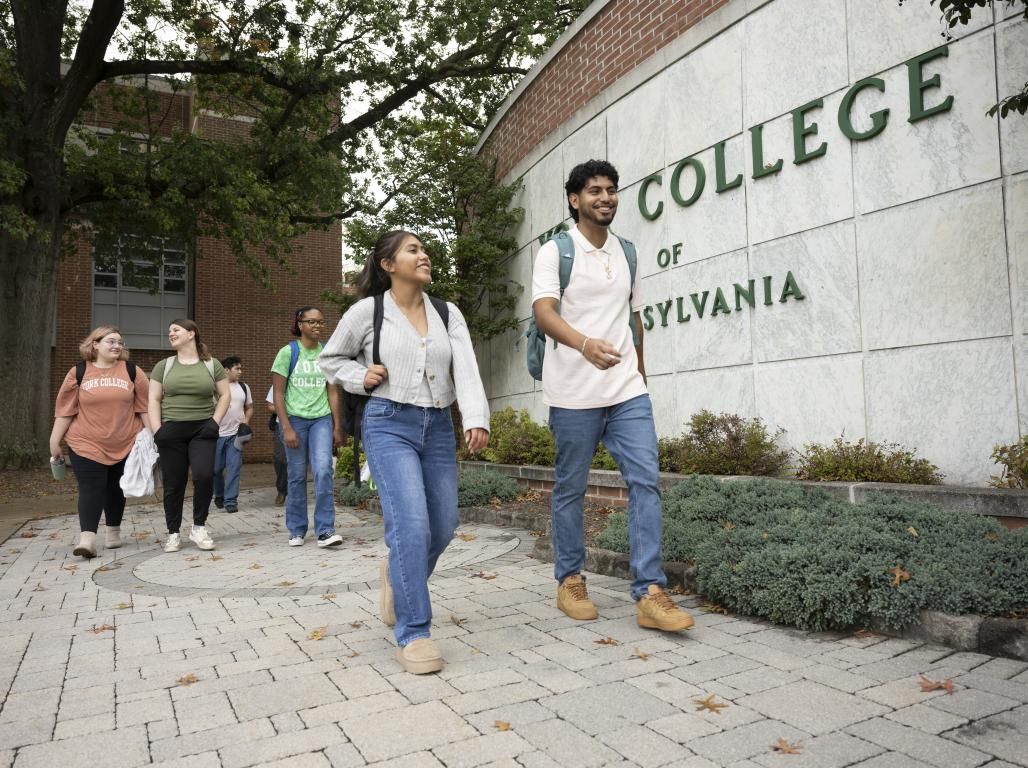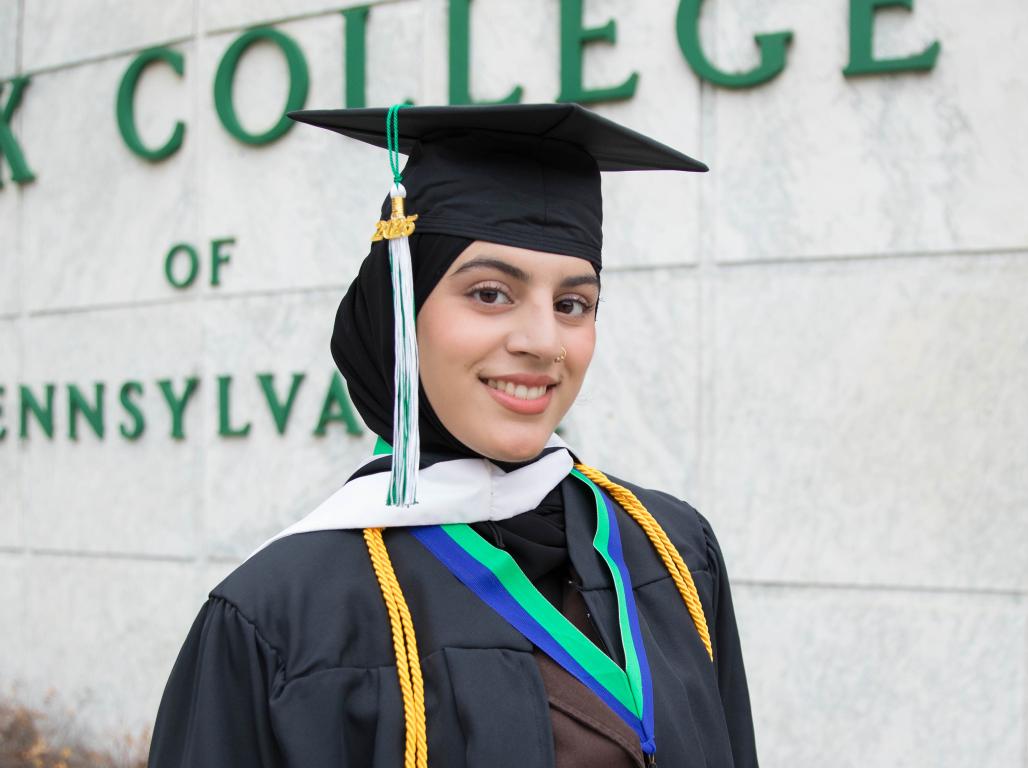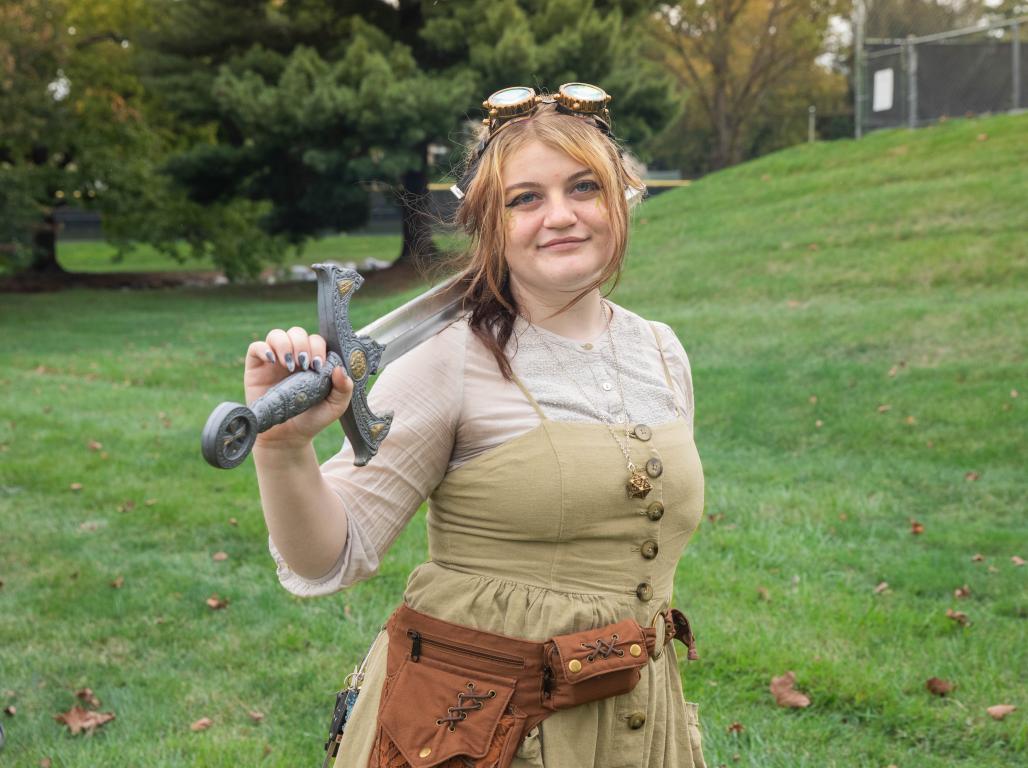Reaching for the Stars: Radio Telescope Brings York College Computer Science and Engineering Students Together for Their Most Ambitious Project Yet

After six years, the efforts of approximately 90 York College Computer Science and Engineering students have led to the completion of the York County Astronomical Society’s very own radio telescope.
John C. Rudy County Park is home to many events and activities. From Envirothon competitions to nature trails for hiking, outdoor enthusiasts are sure to find something to love. But one building in particular holds a very special place in the hearts of York College of Pennsylvania engineering students and professors, and that is the Radio Telescope Observatory.
Its latest addition has been drawing a lot of attention thanks to the combined efforts of York College’s students and the York County Astronomical Society (YCAS). And what is this grand project? It’s none other than a radio telescope!
This telescope detects radio emissions given off from non-man made objects in outer space. Using a specialized receiver and dish antenna, the telescope can detect these emissions from celestial bodies such as the sun, moon, stars, and regions of interstellar space.
The YCAS is thrilled to finally have the telescope functioning. The non-profit was founded in 1989 with a goal of pursuing knowledge and advancement within the study of astronomy. The Society has hosted a large number of events educating people in astronomy but has also continued its own research and projects studying the celestial bodies above.
The radio telescope is simply another step towards that goal.
“We have something very unique here,” Kerry Smith, former YCAS founding president and current society member, said. “Now, we have a research-grade radio telescope, and what excites me the most is not just for the research on our part, but for the educational outreach it will have now.”
Beginning with a Dream
The radio telescope project started in 2018, with a dream Smith had since becoming interested in radio astronomy; he wanted to build a fully-motorized radio telescope.
After reading an article from a 1989 December issue of Sky & Telescope on how short-wave radios could detect radio emissions from Jupiter, Smith made an attempt using his very own ham radio receiver. His radio observations began in January 1990, and after several attempts, Smith captured his first radio emission on February 11th, 1990.
Being able to actually pick up and document those radio emissions after nearly a month of little to no activity left him ecstatic, especially when he reported the time and frequency of the observations to the Society of Amateur Radio Astronomers (SARA). Smith was even told that the radio emissions he observed came from a powerful storm occurring on the planet that night.
Ever since, Smith dedicated much of his time to becoming well-versed in radio astronomy. He even joined SARA, where he would go on to serve the organization as a vice president, a member of the Board of Directors for several terms, and an Educational Chairman and mentor.
As he was nearing retirement in 2017, Smith connected with Donald J. Hake, former full-time Instructor of Computer Science and Department Liaison to Industry and current Adjunct Instructor of Computer Science at York College. Professor Hake did outreach work for the Engineering and Computer Science Departments, looking for client-based projects for them to take on. So, when he heard about Smith’s dream for a radio telescope, Professor Hake proposed that in exchange for helping with the build, Smith would allow senior computer science and engineering capstone classes to take on the project. Smith thought this was a fantastic idea and happily agreed.
Professor Hake even suggested that more could be done with the telescope’s design, such as having it go not just up and down, but be capable of pointing anywhere in the sky and tracking celestial objects. Plus, with the technology available to the students, they could potentially make the instrument Internet accessible to conduct observations from anywhere in the world. In other words, it would be a “remote-controlled, auto-locating, auto-tracking telescope.” To say that Smith was excited was an understatement, and by the summer of 2018, the project was officially underway.
Laying the Foundation
This telescope quickly became one of the largest and most ambitious projects the Computer Science and Engineering Departments took on. In order to make it work, students from Computer Science and three Engineering programs—Computer Engineering, Electrical Engineering, and Mechanical Engineering—were recruited into one capstone project. This meant that several professors from those departments were also involved.
So while Professor Hake would act as project manager, supplying the group with his 30+ years of industry project management experience, Stephen “Drew” Wilkerson, Ph.D., P.E., Associate Professor of Mechanical Engineering, Kala Meah, Ph.D., Professor and Assessment Director of Electrical and Computer Engineering, and David Babcock, Ph.D., Chair for Electrical and Computer Engineering and Computer Science Department, Professor of Computer Science, all contributed their expertise as well.
A lot of planning also had to go into the telescope. Professor Hake emphasized how this would be a very computer science-heavy project, and until now, the Engineering programs did not collaborate with the Computer Science program. So, this would be the first large-scale integration of the Computer Science capstone with Computer, Electrical, and Mechanical Engineering.
Though daunting, Professor Hake believed it would be a good experience for anyone wanting to join the telescope project and would “create a real-world interdisciplinary environment for [the] seniors to work in for their capstones.”
There were several other key factors that needed to be considered when going forward with the production of the telescope. First off, both the workers and the clients involved had to acknowledge that the projects are never “finished.” They had a deadline for how much time they will put towards it and worked to get as much done before then. Once York College hands it off, it will be up to the clients to rework or finish whatever still needs completion.
Thankfully, Smith had a strong background in hardware, prototyping, and radio astronomy, and Todd Ullery, a YCAS member and colleague also assisting with the project, had a background in professional software development.
Second, the projects required a workshop to construct all of the needed parts and a dedicated pool of students. York College’s Kinsley Engineering Center was the perfect location and had no shortage of students interested in taking part in the project.
Along with that, though, Professor Hake realized that since the telescope was going to take several years to complete, they were going to need to establish continuity. If they only had seniors participating, they would essentially have to reteach and reestablish all of the progress they made to the next group of capstone students, which could cost them valuable time.
So, Professor Hake and the other professors decided to recruit high-performing juniors to join and help train the next cohort of students when they themselves became seniors. Independent studies were even offered to some graduating students to allow them one more year to stay on the project.
Finally, there was the matter of financial support. York College granted each of the engineering departments a capstone budget, which they all pooled together to help afford materials and equipment. Along with this, the students were taught how to ask for donations and educational discounts, so outside of what the school provided, York College and the YCAS had around $30-40,000 donated to them worth of supplies.
Getting to Work
When it came to actually working on the telescope, the students were divided into teams. Some worked on constructing the actual instrument itself, while others developed programs that would assist in its additional functions.
For example, the students developed a Windows-based control room application that would allow the YCAS to schedule data-gathering appointments for the radio telescope. Other applications included web development, using cloud-based data, and a phone application that would allow the telescope to be controlled remotely. There was also a considerable amount of effort put toward 3D visualization and software simulation of the radio telescope for testing purposes.
A large amount of work was put into designing and developing the hardware and other major structures for the telescope as well. Tasks included building a support system for the telescope dish, selecting and wiring motors for vital systems such as its gearing system, and choosing what components were needed to drive those motors.
The actual design and assembly of these parts took place in the Kinsley Engineering Center labs and workshops. For the larger components, once they were completed, they would be disassembled and transported to John Rudy Park. A couple of other companies that were either connected to the College or the students working on the project also assisted in assembling the needed parts and sending them to the YCAS members building the instrument.
Overall, the students were making excellent progress. Smith and Ullery were even invited to the Kinsley Engineering Center for weekly updates that the students would hold for their professors and clients, and larger “milestone” presentations every three weeks, detailing everything they had planned, accomplished, and hoped to make progress on by the next update. The professors and the clients were extremely impressed with what the students managed to achieve both on their own and with the resources and support they were given.
“They were held to a very, very tight schedule,” Smith said, “and to produce what they had to produce is nothing short of a miracle because they really pressed hard. And what they accomplished was, in my view, off the charts.”
Overcoming Obstacles
Initially, Professor Hake predicted that the radio telescope would take approximately three years to build. Since the telescope project was officially put into motion in 2018, that meant the projected completion date would be in 2021. However, progress came to a halt during the COVID-19 pandemic.
The main struggle stemmed from the fact that all of the labs and classrooms were hands-on environments, meaning when they were closed down and only allowed a limited number of students to come, very little could be done. This contributed to a loss of momentum and continuity among the students, which in turn led to redesigns of the telescope since the new students coming on weren’t familiar with what they were working on. Plus, the professors had to ensure that the new students understood what they were doing and were still learning.
“In order for the school to keep funding this,” Professor Hake said, “for us to keep doing this as a capstone project, we needed to make sure the students continued to get the academic experience that they are required to have.”
As a result of the delays, the completion date was pushed back to 2023, but when the time arrived, the telescope was still not done. York College had to turn the telescope over to Smith. Although a large amount of progress had been made, it still hadn’t quite reached the condition it needed to be in for full functionality.
“It was workable, but it was not deliverable because there was no way it would have been able to handle the elements outside,” Smith said.
Still, Smith was determined to complete the telescope. In the end, he requested for one more year of support from the College to finish the project. The College agreed and allowed Smith minimal financial support, access to their workshop, and a few independent study students. Smith and the small team reworked the telescope and got its hardware and software into a workable state, and by 2024, they had succeeded.
All parts of the updated telescope were officially delivered to John Rudy Park on May 5th, and finally, the telescope had reached a point of major completion.
Beyond the Classroom
The telescope project allowed many York College students the opportunity to work not only with hardware and software but also be involved with the process of taking on client-based assignments. It was real-world practice that got the students’ hands dirty and exposed them to the industry work many of them would be pursuing after graduation.
Not to mention the wide variety of skills the students practiced and gained from working on the project and with each other. Some of these included working together as a team, good communication, interdisciplinary experience, problem-solving, and learning to accept failure.
The topic of the telescope itself became a great way for now-graduates to get their foot in the door with engineering employers offering jobs and internships as well. The capstone class truly helped set the York College students apart and gave them the chance to network, as many potential employers were invited to attend the capstone students’ updates and presentations recounting the progress made every few weeks.
“All these industry partners and possible employers [came] in to see what our students do, not just this capstone project,” Professor Hake said. “And so, the project, from an employer’s standpoint, was important in the sense that the employers get to see what our students are capable of, and they also get to see the support our students have. So that they know that if [they] get a York College kid, they know their [stuff] because they can do it and have been doing it the whole time.”
Though he doubts that another project of this caliber will happen in the future, Professor Hake knows that the telescope has opened doors to more smaller-scale interdisciplinary work. This was the first time a project pulled everyone from the Kinsley Engineering Center together to collaborate on a common goal. Though stressful and unpredictable at times, the students learned to grow, think for themselves, and truly understand what it means to be an engineer.
As for Smith, finally having his dream radio telescope become a reality has made this a worthwhile endeavor. Though some components still need work, such as the control room, weather station sensors, and cameras, it’s functional. More testing has been done, and the telescope has even gotten to the point that a dish has been mounted on it. If Smith finds that the telescope continues to hold out through the winter, then he estimates that the earliest the instrument could be ready for commission is mid-summer 2025.
If you are interested in seeing the radio telescope in person, come visit the York County Astronomical Society Observatory at John Rudy Park. They host a variety of events catered to any and all astronomy enthusiasts, so check out what lies beyond the sky today.




